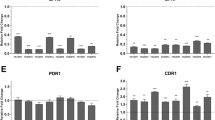Abstract
Candida albicans, the common human fungal pathogen, can switch morphology from yeast to pseudohyphal or hyphal form upon various environmental cues. It is well-known that the ability of morphological conversion and adhesive growth renders C. albicans virulent. It is noteworthy that every factor involved in the morphogenesis is known to be important for the virulence of this pathogen. To examine a functional relevance of Asc1p, a ribosomal protein, in morphogenesis and virulence, an asc1 homozygous null mutant was generated. Although a normal morphological transition of the asc1 deletion strain in liquid media was found, it did not change its morphology on solid media. Moreover, the adhesion activity and hyphal-specific gene expression were defective due to ASC1 deletion. Finally, it was found that the asc1 null mutant was avirulent in a mouse model. These results strongly suggested that Asc1p a component of the 40S ribosomal subunit and a signal transducer, plays a pivotal role in cellular adhesion and virulence through regulation of specific gene expression in C. albicans.
Similar content being viewed by others
References
Baum, S., M. Bittins, S. Frey, and M. Seedorf. 2004. Asc1p, a WD40-domain containing adaptor protein, is required for the interaction of the RNA-binding protein Scp160p with polysomes. Biochem. J. 380, 823–830.
Berman, J. and P.E. Sudbery. 2002. Candida albicans: a molecular revolution built on lessons from budding yeast. Nat. Rev. Genet. 3, 918–930.
Blankenship, J.R., S. Fanning, J.J. Hamaker, and A.P. Mitchell. 2010. An extensive circuitry for cell wall regulation in Candida albicans. PLoS Pathog. 6, e1000752.
Bockmuhl, D.P., S. Krishnamurthy, M. Gerads, A. Sonneborn, and J.F. Ernst. 2001. Distinct and redundant roles of the two protein kinase A isoforms Tpk1p and Tpk2p in morphogenesis and growth of Candida albicans. Mol. Microbiol. 42, 1243–1257.
Calderone, R.A. and W.A. Fonzi. 2001. Virulence factors of Candida albicans. Trends Microbiol. 9, 327–335.
Crampin, H., K. Finley, M. Gerami-Nejad, H. Court, C. Gale, J. Berman, and P. Sudbery. 2005. Candida albicans hyphae have a Spitzenkorper that is distinct from the polarisome found in yeast and pseudohyphae. J. Cell. Sci. 118, 2935–2947.
Gerbasi, V.R., C.M. Weaver, S. Hill, D.B. Friedman, and A.J. Link. 2004. Yeast Asc1p and mammalian RACK1 are functionally orthologous core 40S ribosomal proteins that repress gene expression. Mol. Cell. Biol. 24, 8276–8287.
Johnston, D.A., K.E. Eberle, J.E. Sturtevant, and G.E. Palmer. 2009. Role for endosomal and vacuolar GTPases in Candida albicans pathogenesis. Infect. Immun. 77, 2343–2355.
Kim, S.W. 2010. Functional study of ASC1 in adhesion and virulence in Candida albicans. Master’s Thesis, In Laboratory of Biochemistry, School of Life Sciences & Biotechnology. Korea University, Seoul.
Kleinschmidt, M., R. Schulz, and G.H. Braus. 2006. The yeast CPC2/ASC1 gene is regulated by the transcription factors Fhl1p and Ifh1p. Curr. Genet. 49, 218–228.
Li, F. and S.P. Palecek. 2003. EAP1, a Candida albicans gene involved in binding human epithelial cells. Eukaryot. Cell. 2, 1266–1273.
McCahill, A., J. Warwicker, G.B. Bolger, M.D. Houslay, and S.J. Yarwood. 2002. The RACK1 scaffold protein: a dynamic cog in cell response mechanisms. Mol. Pharmacol. 62, 1261–1273.
Naglik, J.R., S.J. Challacombe, and B. Hube. 2003. Candida albicans secreted aspartyl proteinases in virulence and pathogenesis. Microbiol. Mol. Biol. Rev. 67, 400–428, table of contents.
Netea, M.G., G.D. Brown, B.J. Kullberg, and N.A. Gow. 2008. An integrated model of the recognition of Candida albicans by the innate immune system. Nat. Rev. Microbiol. 6, 67–78.
Nilsson, J., J. Sengupta, J. Frank, and P. Nissen. 2004. Regulation of eukaryotic translation by the RACK1 protein: a platform for signalling molecules on the ribosome. EMBO Rep. 5, 1137–1141.
Nobile, C.J., D.R. Andes, J.E. Nett, F.J. Smith, F. Yue, Q.T. Phan, J.E. Edwards, S.G. Filler, and A.P. Mitchell. 2006. Critical role of Bcr1-dependent adhesins in C. albicans biofilm formation in vitro and in vivo. PLoS Pathog. 2, e63.
Nobile, C.J. and A.P. Mitchell. 2005. Regulation of cell-surface genes and biofilm formation by the C. albicans transcription factor Bcr1p. Curr. Biol. 15, 1150–1155.
Sudbery, P., N. Gow, and J. Berman. 2004. The distinct morphogenic states of Candida albicans. Trends Microbiol. 12, 317–324.
Valerius, O., M. Kleinschmidt, N. Rachfall, F. Schulze, S. Lopez Marin, M. Hoppert, K. Streckfuss-Bomeke, C. Fischer, and G.H. Braus. 2007. The Saccharomyces homolog of mammalian RACK1, Cpc2/Asc1p, is required for FLO11-dependent adhesive growth and dimorphism. Mol. Cell. Proteomics 6, 1968–1979.
Vomastek, T., M.P. Iwanicki, H.J. Schaeffer, A. Tarcsafalvi, J.T. Parsons, and M.J. Weber. 2007. RACK1 targets the extracellular signal-regulated kinase/mitogen-activated protein kinase pathway to link integrin engagement with focal adhesion disassembly and cell motility. Mol. Cell. Biol. 27, 8296–8305.
Whiteway, M. and C. Bachewich. 2007. Morphogenesis in Candida albicans. Annu. Rev. Microbiol. 61, 529–553.
Author information
Authors and Affiliations
Corresponding author
Rights and permissions
About this article
Cite this article
Kim, S.W., Joo, Y.J. & Kim, J. Asc1p, a ribosomal protein, plays a pivotal role in cellular adhesion and virulence in Candida albicans . J Microbiol. 48, 842–848 (2010). https://doi.org/10.1007/s12275-010-0422-1
Received:
Accepted:
Published:
Issue Date:
DOI: https://doi.org/10.1007/s12275-010-0422-1




